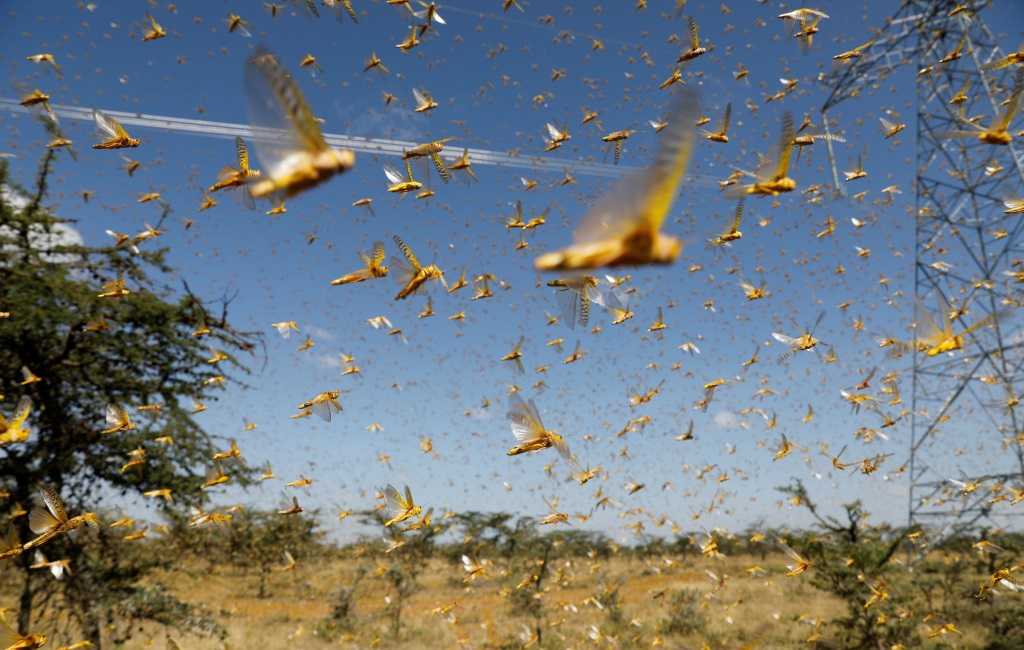Bad to worse: Looming locust attack amid coronavirus panic

Collected
Bangladesh’s response to natural disasters could be tested yet again amid the coronavirus crisis as a massive stream of desert locusts could be heading towards Bangladesh and India passing over the Indian Ocean.
Bangladesh is already reeling with the increasing number of coronavirus infections and deaths. This possible attack from the crop destroying insects may worsen the problem further.
Citing top officials of the Indian Government, the Hindu, a respected newspaper of India, said a locust stream passing over the Indian Ocean may attack farms in peninsular India, and head towards Bangladesh.
Another stream might travel over a land corridor passing over Yemen, Bahrain, Kuwait, Qatar, Iran, Saudi Arabia, Pakistan, and India, impacting farmlands in Punjab, Haryana, and the Indo-Gangetic Plain, it said.
“This can result in a serious food security issue,” The Hindu said quoting the Indian official.
Bangladesh saw a limited scale destruction by a horde of unknown insects in Cox’s Bazar recently.
A couple of days ago, a horde of unknown insects devoured the trees of an abandoned farm house in Cox’s Bazar’s Teknaf upazila, leaving no leaves on the trees.
Md Abul Kashem, deputy director of Cox’s Bazar Agricultural Extension office, told Dhaka Tribune they have never seen this sort of insect before.
Kashem said: “The insects involve some similarities with grasshoppers but are smaller in size. We took some photographs and videos of the insects and sent them to your hq in Dhaka and the Entomology Department of Bangabandhu Sheikh Mujibur Rahman Agricultural University.
“The insect horde was confined in an abandoned house and we destroyed them by spraying insecticide. That they had no wings, their bodies were soft, plus they burst with a sharp sound whenever we sprayed insecticide,” he informed.
“But the insect is very destructive. There have been no leaves left on the trees. It really is still unknown how they got here,” Kashem added.
Dr Md Ruhul Amin, professor of the Department of Entomology at BSMRAU, said: “I've seen the photographs and the video sent from Cox’s Bazar. The insect looks like a locust in the nymphal stage. Wings are yet to be grown nonetheless they may fully turn out following the nymphal stage. But it is difficult to state exactly what it is without observing it physically.
“It is possible these were passing an ocean with a blast of locusts. Sometimes they fly and sometimes they might be carried by the wind before becoming a grown-up, regardless of the wingspan,” he added.
However, Dr Md Abdul Muyeed, director general of the Department of Agricultural Extension, said: “The insects observed in Teknaf are a sort of grasshopper, however, not locust. But we are writing to the Entomology Department of Bangladesh Rice Research Institute to recognize what kind of insect it is.”
“We will collect more info on the matter based on the report published by the Hindu.” he added.
“Locusts are incredibly destructive. They eat all of the crops on their way,” commented Muyeed.
Regions in danger
As per the Food and Agriculture Organization (FAO) of the United Nations Locust Watch update of April 21, desert locust swarms are damaging crops in African countries at an alarming rate.
Meanwhile, their breeding continues in a number of countries of the Arabian Peninsula, including Yemen, Saudi Arabia, Iraq, Oman, and UAE, creating hopper or non-flying nymphal bands to form that could bring about swarms.
It also discussed the problem in Southwest Asia saying there are hopper groups and bands in the Indus Valley and Punjab and limited breeding near the Indian border.
Locust swarms will gravely heighten the threat to food security in the Afro-Asian region, warned FAO.
According to Indian media outlets, some Indian states have already been influenced by desert locusts, that is a bad omen for neighbouring Bangladesh.
Prof Ruhul Amin said: “If the locust stream reaches India, it will surely come to Bangladesh.
“Some newly introduced foreign trees could be the reason behind the attraction of locust to the united states,” he added.
How destructive is a locust swarm?
Locust swarms-potentially containing hundreds of millions of individual desert locusts-can move up to 150 kilometres a day, while devastating rural livelihoods within their relentless drive to consume and reproduce, according to FAO.
How big is a locust swarm can range between less than one square kilometre to many hundred square kilometres.
The destructive power of a typical locust swarm is enormous. A one square kilometre swarm, containing about 40 million locusts, can eat as much food as 35,000 persons consume per day, assuming that every individual consumes 2.3 kg of food each day.
Source: https://www.dhakatribune.com